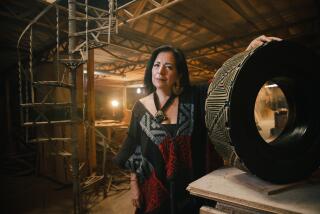Performance Art : Mythology Exposed in ‘1991’ at Highways
- Share via
There is a painting from Jose Maria Obregon titled “The Inspiration of Christopher Columbus.” In it the explorer sits before the Atlantic, his gaze innocent and his profile sleek, ready to meet his destiny. This is the romanticized Columbus, and it is the mythology behind this image that performance artist Guillermo Gomez-Pena sets out to deflate, ridicule and subvert in “1991,” the second part of a performance trilogy called “1992,” at Highways in Santa Monica.
Gomez-Pena assumes the role of a Third-World artist, a polemicist who uses language and performance to deconstruct dominant dogma. Whether garbed as an Aztec prince, zoot-suiter or charro, he pulls his audience along on a journey from 1492 to the present with a gallery of enraged, wretched, funny and outrageous personae who represent the historical victims of Columbus and his heirs.
To set the tone for all that is to follow, the performance begins at the ticket booth. Depending on whether you are monolingual, bilingual or more, you are assigned to a section of the theater-gallery. Predictably, each section assumes symbolic significance in a performance ritual bent on dissecting the atrocity of ethnocentrism.
Once inside, you find a lone leather-clad electric guitarist, the surreal Sergio Arau. Playing and singing against a backdrop of recorded ranchera-inspired neo-punk, he satirizes flamboyant machismo.
Into the middle of this, a barefoot Gomez-Pena enters wearing red briefs and the makeshift regalia of an ancient Aztec noble. As Arau continues his plaintive love songs in raspy Spanish, Gomez-Pena creates his art space by placing paraphernalia strategically around the stage. Arau departs, and Gomez-Pena begins his “chronicle of the re-discovery of America by the Warrior of Gringostroika.”
Propelled by sheer energy, an often humorous script and a phenomenal voice that he “plays” like a fiery instrument of intonation, invective and emotion, Gomez-Pena pulls out all the stops. Whether he’s punching a dead chicken while draped in a black mourning veil, dancing like an over-anxious transvestite entertainer, or barking nervously like a dog on all fours, he holds nothing back.
More than once, the visual extravaganza overwhelms and dilutes the ideas behind the work. The artist loses control, and we are left to watch the elements of the piece run wild. But there are magical moments too. If true theater occurs when the human condition is illuminated, then theater of the highest order emerges here. In these fleeting glimpses, the work is lifted above and beyond even the cleverest polemics of its creator.
In one such highlight, Gomez-Pena holds his feet over votive candles and remembers aloud. “I remember,” he sadly intones as he runs through a litany of laments. The image evokes the death of the last Aztec leader, Cuauhtemoc. Legend has it that while Cortez held the leader’s feet to the fire, demanding submission, the Indian warrior remained silent to the end.
So basic to the ideal of stoic self-sacrifice, the mythic scene was memorialized in a mural by Siqueros. In the performance, the image becomes a multilayered visual reference point. Combined with the artist’s truly vulnerable reminiscences of an internal life born in large part from ethnic stereotypes produced by U.S. culture, it becomes conceptual art at its best.
Later, wearing a zebra-striped zoot-suit, Gomez-Pena becomes an old man--one of the shattered lives, the shell-shocked sacrificial lambs of the border world. Tottering on a cane, he peddles what remains of his soul. His cultural self in tatters, ripped to shreds by the cutting machinery of social and economic sadism, he is the final vestige of the prostituted Third World. This vignette is the structural culmination of the performance.
Certainly there is imagination and immediacy in “1991.” As is often the case with performance art, there are also too many rough edges. The piece recycles aspects of an earlier work, the more elegant “Border Brujo.” It chooses easy targets and ends on a cliched note that seems to give racism a false promise of eventual victory. Still, Gomez-Pena has brought passion, ideas and drama to the bare stage at Highways, a fitting gift from a migrant artist on the weekend of the day of the dead.
More to Read
The biggest entertainment stories
Get our big stories about Hollywood, film, television, music, arts, culture and more right in your inbox as soon as they publish.
You may occasionally receive promotional content from the Los Angeles Times.










